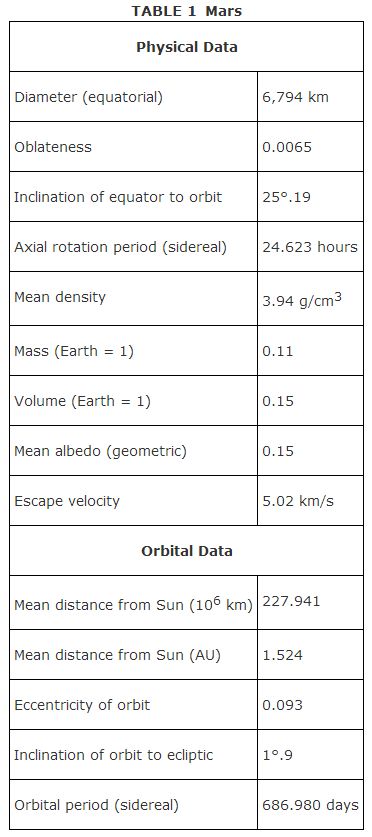An intermediate‐sized terrestrial planet, Mars has a cratered, reddish surface that is now structurally inactive, as the last active vulcanism ended some 1.5 billion years ago. Although it has no global magnetic field, mapping its patterns of surface magnetism reveals parallel strips of land with opposite magnetic polarity, analogous to the magnetic patterns found on Earth on either side of the mid‐oceanic ridges. These strips of land suggest that very early in its history, before it had cooled significantly, Mars had an inner molten core that was able to generate a magnetic field and an outer mantle that was convecting to produce plate tectonic phenomena at the surface. Today, the planet's surface preserves the greatest range of elevation of any of the terrestrial objects, from a 1,300 kilometer‐wide crater in the northern hemisphere, whose floor is 10 kilometers below mean elevation, to the 25 kilometer‐high Olympus Mons, the largest volcano in the solar system. Olympus Mons is an example of a shield volcano, formed when thin lava spreads out over a large area. The diameter of this extinct volcano is 600 kilometers, or three times the wide size of the largest Earth volcano of this type (located in Hawaii). Volcanic resurfacing of the planet affected primarily the planet's northern hemisphere, which is covered with relatively smooth plains. The older southern hemisphere surface shows the accumulation of many more craters over time.
The cratered regions show the influence of weathering. The uncratered regions, large “deserts” covered with sand dunes, show seasonal changes in appearance as the annual cycle of winds moves the loose dust from one area to another. Canyon areas are apparently due to erosion by wind, old lava scouring of channels, and/or water, although no liquid apparently exists on the planet's surface today. Remote satellite mapping of the planet's surface is becoming more detailed, with increasing evidence that surface water flow has left characteristic erosion channels. A major equatorial canyon, Valles Marineris, is 4,000 kilometers long, with tributary canyons. It was likely caused by uplift (a bulge formed by internal movement of deep subsurface molten material) and splitting of the Tharsis region on the planet (not a rift valley as found on Earth). The existence of teardrop‐shaped islands, ancient river channels, and flood plains all suggest flow of water on the surface, but any water now on the planet must be locked into the surface rocks in the form of a permanent tundra or permafrost.
The ice caps wax and wane with the seasons (globally, the temperature is cold, averaging 220 K = −60°F, with ±30 K seasonal variation). These ice caps are composed primarily of carbon dioxide and possibly some water, representing a substantial, frozen fraction of the planet's thin atmosphere. As a consequence, the atmospheric dynamics of Mars are far different from that of Earth. In the Martian northern hemisphere spring, the northern ice cap begins to shrink with the liberated carbon dioxide moving south only to be frozen into the southern hemisphere ice cap. At the onset of the southern hemisphere spring, the process is reversed. In spite of its thinness, the atmosphere can produce high velocity winds and planet‐wide dust storms. Dust settling onto the ice caps is left behind when the ice sublimates each spring, forming more or less concentric terraced areas about the poles.
This Martian atmosphere has a surface pressure about 1 percent of that of Earth, far less than expected based on the planet's volcanic past. Because the planet's gravity is sufficient to have retained its atmosphere, another cause must exist to explain its lack of an atmosphere. It has been suggested that most of the original atmosphere may have been lost in a meteoric collision event long ago or possibly eroded away by interaction with the solar wind. Compositionally, what little air there is consists of 95 percent carbon dioxide, 3 percent nitrogen, and 1.5 percent argon, with seasonal trace amounts of water, oxygen, and helium. Its density falls off with altitude more slowly than on Earth, thus at a height of 50 kilometers, the Martian atmosphere is actually denser than that on Earth at the same height. The atmosphere thus can support high clouds, generally in the morning. (See Table 1 for Mars's physical and orbital data.)

Internally, the planet's structure follows the characteristic crustmantle‐core structure. The planet's low mean density of 3.9 g/cm 3 suggests a relatively small iron core. No evidence exists for current tectonic activity.
Two small irregularly shaped moons, Phobos (roughly 28 km by 23 km by 20 km) and Deimos (approximately 16 km by 12 km by 10 km), orbit the planet, each keeping its long axis always pointing toward the planet for the same reason that the Moon keeps the same face toward Earth. Both are heavily cratered and likely are captured asteroids, not objects that formed in conjunction with the formation of the planet. Phobos (the one in the lowest orbit) is slowly spiraling in toward the planet because of atmospheric friction and is predicted to crash to the surface within the next 100 million years.
|
|
|
|
|
|
|
|
|
|
|
|
|
|
|
|
|
|
|
|
|
|
|
|
|
|
|
|
|
|
|
|
|
|
|
|
|
|
|
|
|
|
|
|
|
|
|
|
|
|
|
|
|
|
|
|
|
|
|
|
|
|
|
|
|
|
|
|
|
|
|
|
|
|
|